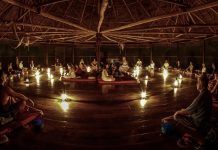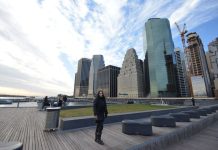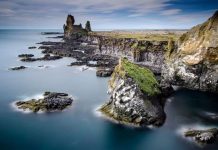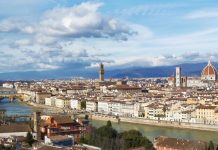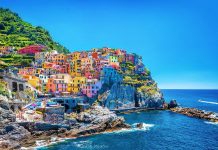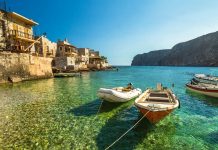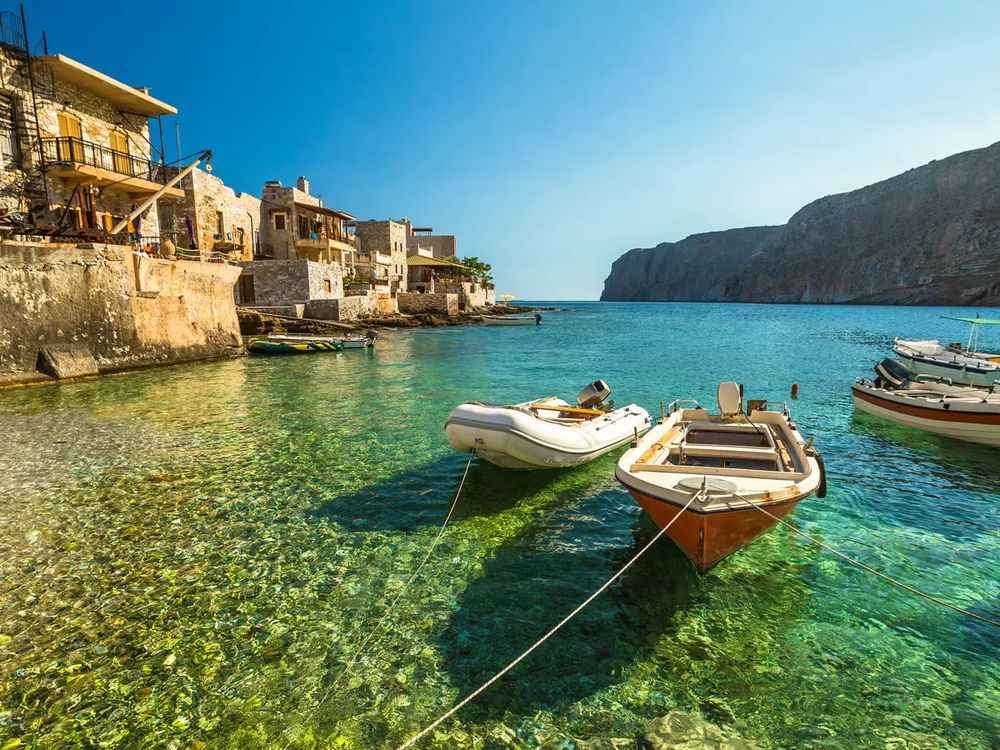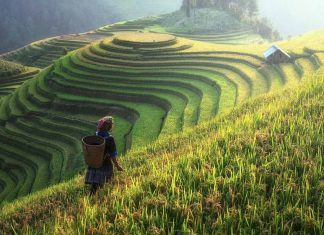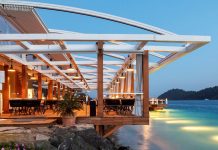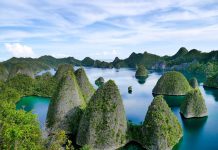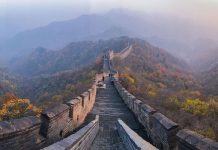Aghii Iasonas and Sosipatros: It is the most important monument of mid Byzantine period and the only church of Byzantine architecture in Corfu (Kerkyra). In Greece, it is one of the most well-preserved temples of this type, built around 1000 A.D. at the area of Anemomylos. The construction of a luxurious church at the suburbs, so far away from the fortified town, shows the prosperity and the safety that Corfu (Kerkyra) enjoyed during these years. In the built baroque templon of the 18th century, you will see admirable post-byzantine icons. It is also worth seeing the two large portable icons of the saints and saved wall paintings of the 11th and 14th century. Here are kept the relics of the two saints, Iason and Sosipatros.
Aghii Pantes: This historic church was built in 1688, but its current form was evolved when it was connected to the church of Virgin Mary Vlaherena (1851). Here, you can admire the templon with the famous portable icons and the icon of Virgin Mary Vlaherena, that were brought to the “new” church, the three templon doors and icons, covered with silver sheets and “Jesus on the Cross” in the Altar.
Aghios Antonios: It is an historic church, situated in the end of the road from the Liston to the Old port of Spilia. This is the church in which the emperor Ioannis VIII Paleologos (brother of Konstantinos Paleologos, last Emperor of the Byzantine Empire) attended the Mass in 1437. Also, here, the Ecumenical Patriarch Joseph and the Imperial escort stopped, during their journey to Ferrara (congress of Ferrara).
Aghios Franghiscos of Assisi: This church, one of the most historic churches of Corfu (Kerkyra), is a living historic monument of the schism and the rivalry of the Orthodox and the Catholic Church. When the d’Anjoux took over Corfu (Kerkyra) (d’Anjou-1272) they eliminated the Orthodox Archbishop and took from the Orthodox the best churches. In 1367, the church was given to the Latin monks of Saint Francis of Assisi and, only in 1943, after the end of World War II, the Catholic Vicar gave to the Orthodox Cathedral of Corfu (Kerkyra) the holy relics of Saint Arsenios, Iason and Sosipatros, which were kept in a crypt of the church.
Aghios Georgios in the Old Fortress: It is a former Anglican church for the English soldiers, located inside the Old fortress. Its interior was destroyed by the German bombardments in 1943 and it was restored to its original form in 2008. After the unification of the Ionian Islands to Greece (1864), it became an Orthodox church and the old stone templon of the church of Aghios Spyridon was installed here. It was the only church in Corfu (Kerkyra) where the night Mass of the Resurrection was held, until the mid 20th century, when it was transferred to the church of Aghia Paraskevi, where it is being held until today.
Aghios Ioannis Prodromos (Saint John the Baptist): This church was created by families of the noble class in the 15th century. It is the only church which has the pulpit on the southern wall, in order for the people to hear the orator, regardless of religion or creed. Here, you can see the templon of Corfiot marble, with the icons by known hagiographers of the Cretan-Corfiot School, the icons of Christ and the icons of the templon of the most famous and skilled hagiographers of the Ionian School. Here are kept the relics of Aghios Ioannis Chrysostomos and Aghios Ioannis Damaskinos. This is the church that attended the National Poet of Greece Dionysios Solomos and Ioannis Kapodistrias, the first governor of Greece.
Aghios Nikolaos dei Vecchi (of the old people): The church was built in the 14th century, but it took its current form in 17th century, when its carved templon and the baroque chapel of Aghios Nikolaos were constructed. It is situated in the end of Philarmonikis Street, on the stairway that goes to Kampielo. It is here that was baptised Ioannis Kapodistrias (1776), the first governor of Greece (1828). The church was given to the Serbs to serve as a Cathedral during World War I, when Corfu (Kerkyra) welcomed the exiled government and what was left of the Serbian army (1916). In this church you will find the largest part of the Holy Cross in Corfu (Kerkyra), as well as part of the relics of Aghios Nikolaos and Aghios Lazaros. You can also admire remarkable icons on the outside part of the templon and the icon of Panaghia Kyropoula (Virgin Mary Kyropoula).
Aghios Spyridon: Aghios Spyridon is the patron saint of the island. The church has been built in 1589, with the contribution of the Corfiot community. It is situated in the street “Aghios Spyridon”, a street vertical to the northern part of Liston. The main feature of the church is its huge bell tower, predominant in Corfu (Kerkyra) Town and you will recognize it as you will be walking through the old town and the castles. The bell tower resembles a lot the bell tower of the Greek church of Venice (San Giorgio dei Greci). Here, you can admire the painted ceiling of the 19th century, the marble templon, the oil lamps, the portable icons and the luxurious reliquary, where the holy relics of the Saint are kept. The relics were taken to Constantinople in the 7th century, but, after the fall of Constantinople by the Ottomans, it was moved initially to Arta (Epirus) and then to Corfu (Kerkyra). Several miracles are mentioned during the lifetime of the Saint and since the relics came to Corfu (Kerkyra). The most important of these are celebrated until today with processions and ceremonies, four times in the year; the procession on Easter Saturday because in 1553, the Saint saved the island of famine, the procession on the Orthodox Palm Sunday because i0n 1630 he relieved the island of the plague, the procession on the first Sunday of November because in 1673 he intervened once more, saving again Corfu (Kerkyra) of the plague and the procession on 11 August because in 1716 he relieved the island of the siege of the Turkish army.
Early Christian Basilica: The Early Christian basilica at Paleopolis is one of the most important Byzantine monuments and the most important monument of the Early Christian era. It was built in the 5th century by Jobianus, bishop of Corfu (Kerkyra). The church was destroyed by bombardments during the World War II. Panaghia Kremasti (Virgin Mary Kremasti): It is a simple Ionian church, built before the 16th century. In its interior, you can admire its geometric decoration and its luxurious interior with the marble templon, the doors of which are decorated with representations of vine leaves and impressive large icons (18th century). It is situated in Kampielo, one of the most beautiful squares of the old town of Corfu (Kerkyra), with the famous well in its centre. The wells are a main feature of many squares in Corfu (Kerkyra), because that is how the town was irrigated, before the aqueduct was constructed during the English rule, by the English Commissioner Adam.
Panaghia of Kseni (Virgin Mary of the Foreigners): This majestic church, devoted to Panaghia Faneromeni, is situated in the centre of the old town, in the corner which the Corfiots call “Plakada t’Aghiou”. It is built in the beginning of the 18th century and has been the community church of people from Epirus, who had arrived in Corfu (Kerkyra) as financial and political immigrants. Here, you can admire its wooden templon.
Panaghia of Tenedos (Virgin Mary of Tenedos): It is a catholic monastery of the early 18th century, built between 1678-1688. It is an important, architecturally, church with important history. It owes its name to the monks that had to abandon Tenedos island, after its fall to the Ottomans (1657) and came to Corfu (Kerkyra), bringing along the beautiful icon of the Virgin Mary. The monastery was the first house for the public library of Corfu (Kerkyra) (1800-1807), the first Greek teacher’s school (1805) supervised by Ioannis Kapodistrias and the first Greek printing house, where the patriotic hymn “Thourios” of Rigas Ferreos was imprinted (he was a martyr of the Greek revolution 1821).
Panaghia Spileotissa (Virgin Mary Spileotissa): The church was built in 1577, but it evolved to its current form in 1913. It took its name after the gate “Porta Spilea”, one of the main entrance to the Town. In 1841, became the Cathedral of Corfu (Kerkyra). It was then that the icon of Virgin Mary Dimosiana, protector of Corfu (Kerkyra) Town during the 15th century, was transferred here, with the relics of Aghia Theodora the Emperess, brought to Corfu (Kerkyra) from Constantinople in 1456). Here, you can see the templon and the icons of the 16th century, the large icon of the Crucifixion and the three oversized paintings of Italian manner, with representations of the Old Testament, parts of a tetralogy (the fourth painting of which was destroyed by the bombardments of World War II).
Pantokratoras: It is a typical simple Ionian church, built in the beginning of the 16th century. It is situated in Taxiarhes Square at Kampielo. The main characteristic of this church is the carved angel on top of the roof, made by the Italian sculptor Toretti in the 18th century. The church was seriously damaged, by a Nazi bombardment during World War II, which, also, caused the destruction of Taxiarhes church that was in the church of Pantokratoras.
Pantokratoras at Pontikonissi: It is a small Byzantine church, built in 11th or 12th century, dedicated to the Transfiguration of Christ. It is situated in the tiny islet at the entrance to the lagoon of Halikiopoulo, opposite Kanoni. It is in shape of a Greek cross with an octagonal dome in the center, and has one central three-sided apse behind the altar.
Platytera Monastery: The monastery, devoted to Panaghia (Virgin Mary), to Aghios Chrysanthos and Aghia Daria, is situated at the northern entrance to the town, between the suburbs of Aghios Rokkos and Mandouki, 1km far from the town’s centre. It was built in 1774, destroyed during the first French rule (1797-99) and rebuilt immediately. You can admire a very interesting collection of post-byzantine icons made by important painters and the artistic wood-carved templon covered with sheets of gold and silver. Here, you will also find the tombs of Ioannis Kapodistrias, the first governor of Greece, as well as of several eparches of Corfu (Kerkyra) and you can visit its library.
Saint Jacob’s Catholic Cathedral (Duomo): It is the Cathedral of the Catholic community and it is located at the Town Hall square. It has had serious damage after a Nazi bombardment during World War II (1943) and it was restored with the typical baroque curve at the upper front part, the Gothic tower and the tall belltower.
CHURCHES AND MONASTERIES IN NORTH CORFU (KERKYRA)
Hyperaghia Theotokos Monastery at Magoulades: The monastery is situated in Magoulades area, in the northern part of Corfu (Kerkyra) and it is one of the most old and largest monasteries in the island (10th century). The monastery, because of the importance and the greatness of its architecture and its heirlooms, has been listed as Historic Monument. Here, you can admire the icons of the monastery (18th century).
Monastery of Panaghia Paleokastritsa (Kastromonastiro of Panaghia): It was founded in 1225, however, after certain transformations, it was formed in its current shape in 16th-18th century. It is named after Paleokastritsa (which means “of the Old Castle”), because the first buildings were parts of an older fortification. It was destroyed by the Genovese in 1403, rebuilt in 1469 and destroyed again in 1537 by the Turks. In 1572 it was built again and it is still preserved with several additions and repairs, like the northern entrance of 1722. Here, you can visit the museum with Byzantine and post-byzantine icons, books etc. and you can admire the wonderful view.
Panaghia Kassopitra (Virgin Mary Kassopitra): The church is one of the most important religious monuments in the north Corfu (Kerkyra). It is situated in the end of the main street of Kassiopi, 20m. far from the port. The church was first built in 1721 and rebuilt in its current form in 1850. The church is built on the foundations of a Roman temple. On May 8, the inhabitants honour Panaghia Kassopitra (Virgin Mary) for healing from blindness a boy, in the 16th century, when he presented to her icon.
CHURCHES AND MONASTERIES IN SOUTH CORFU (KERKYRA)
Panaghia Eleousa (Virgin Mary Eleousa): The monastery of Panaghia Eleousa (Beata Vergine Eleusa) was built in the 16th century, at Lefkimi, on top of a nearby hill, “Arkoudilas”, offering a panoramic view of the island. It has been built by the Venetians and, historically, it is very interesting, because, during the World War II, here, it was established the Greek emplacement.
Panaghia Kyra ton Aggelon at Lefkimi (Virgin Mary of Angels): The monastery was built in 1696, at Lefkimi, by the descendants of Kapodistrias, the first governor of Greece. Later on, besides the temple, more buildings have been built, in order to host those who were suffering of plague. During the English rule, Englishmen had all the buildings destroyed, but not the church, which has been restored in 1935. Both monasteries are the town’s most significant landmarks.

